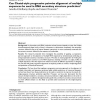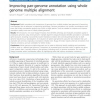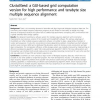26 search results - page 3 / 6 » Multiple sequence alignment using a GLOCSA guided genetic al... |
CANDC
2005
ACM
13 years 6 months ago
2005
ACM
We propose an algorithm of global multiple sequence alignment that is based on a measure of what we call information discrepancy. The algorithm follows a progressive alignment ite...
BMCBI
2007
13 years 6 months ago
2007
Background: In ribonucleic acid (RNA) molecules whose function depends on their final, folded three-dimensional shape (such as those in ribosomes or spliceosome complexes), the se...
BMCBI
2010
13 years 6 months ago
2010
Background: Determining beforehand specific positions to align (anchor points) has proved valuable for the accuracy of automated multiple sequence alignment (MSA) software. This f...
BMCBI
2011
12 years 9 months ago
2011
Background: Rapid annotation and comparisons of genomes from multiple isolates (pan-genomes) is becoming commonplace due to advances in sequencing technology. Genome annotations c...
BMCBI
2010
13 years 6 months ago
2010
Background: There is an increasing demand to assemble and align large-scale biological sequence data sets. The commonly used multiple sequence alignment programs are still limited...



